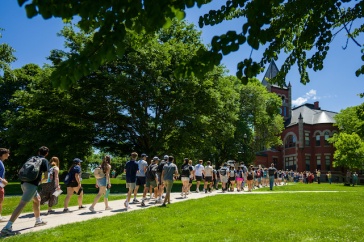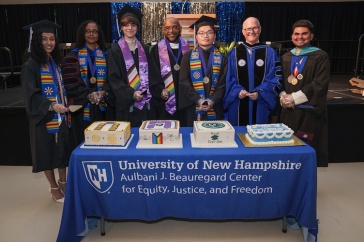 |
In 1941, the debate over gender roles and the fight for equal rights for women at UNH boiled down to one very simple idea: Denim.
With the attack on Pearl Harbor and the U.S. entry into World War II, traditional campus activities in Durham came to a temporary halt as many young UNH men signed up to serve in the military. Intercollegiate sports and some clubs and social events were suspended. Female students were advised to include a “war training” course in their studies so that after graduating they could replace the men leaving the workforce for military service. Those with aptitude in mathematics and physical science were urged to enroll in special engineering war courses, such as the aeronautical aide fellowship program sponsored by the Pratt & Whitney Aircraft Corporation.
Estelle Dutton Wall ’45 was one of 15 women accepted into the first class of “P&W Girls.” When she and her classmates walked into the previously males-only territory of the engineering labs in Demeritt Hall, they were dismayed to find them very dingy and dirty—not suitable workspaces for their dresses and skirts. “When we started in the lab courses my friends and I went to Dover to buy jeans—an unheard of thing for coeds!” Wall recounted years later. “When we asked for jeans according to waist size, imagine our surprise to find we could not begin to get them over our hips!”
The university returned to its regular operations after the war, but, much to the men’s chagrin, the women were reluctant to give up the casual clothing they had come to enjoy. In October 1945, a group of unhappy male students organized the Committee for the Abolishment of Dungarees, or CAD. Members signed a pact stating that if the girls did not stop wearing men’s shirts and dungarees within one week, they would all stop shaving.
The women responded by establishing the Daughters of Dungaree Tolerance. “Are the men the only ones entitled to the comfort of trousers and the convenience of pockets?,” they wrote in a letter that appeared in The New Hampshire.
They then stated their platform in rhyme:
Let ’em itch and let ’em squirm,
From nubbly shins and whiskers firm.
If they don’t shave—what the hell,
Our dungarees make us feel swell!
In the next edition of The New Hampshire, the men countered with a ditty of their own:
You girls in slacks
Look like whacks,
Wearing our dungarees.
You can wear our shirts
Until it hurts,
But not on campus please!
At 12:45 p.m. on the day of the deadline, members of CAD assembled in front of East and West Halls then made their way to the Commons (now Huddleston Hall), led by a makeshift band. CAD’s chairman gave a speech to a small crowd, expounding on the evils of girls in dungarees. Every girl who owned or was able to get a pair of dungarees had them on. The band then marched to the women’s dorm, Fairchild Hall, and began serenading the girls inside with their rendition of The Old Gray Mare. Thinking CAD needed some cooling off, a group of women attempted to throw a bucket of water on their chairman.
The meeting broke up when classes resumed, and the women continued to don their dungarees. The UNH faculty and administration remained neutral throughout the feud, though President Harold Stoke later stated he didn’t care what the women wore as long they were comfortable. And while CAD may
have failed in its mission to get the women to stop wearing men’s
clothing, it did succeed in stirring up a big dose of school spirit.
Originally published in UNH Magazine—Fall 2014 Issue
-
Written By:
Mylinda Woodward '97 | University Archives | mylinda.woodward@unh.edu | 603-862-1081
















































